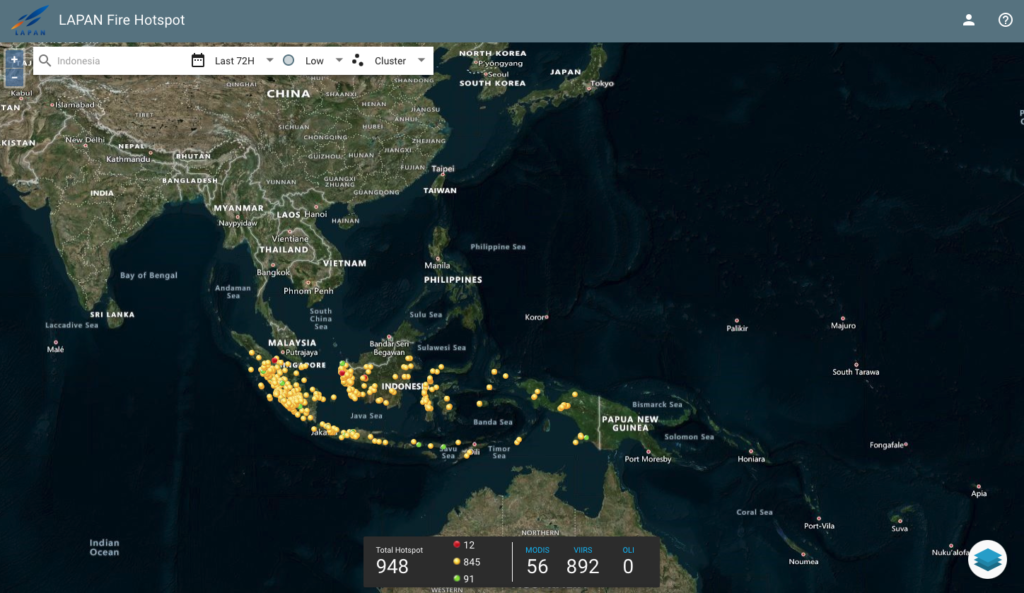Annual fire season has started again, number of hotspots in Sumatra, Kalimantan increases in 2022.
Meteorologists are predicting 2022 will see the return of hot, dry and fire-prone conditions known as El Niño, a climate pattern that’s becoming more frequent and severe due to climate change. According to experts, peatland, as an accumulator of carbon is highly combustible and hard to extinguish once ablaze. The release of carbon potentially increases greenhouse gas emissions.
RELEVANT SUSTAINABLE GOALS


Fire Hotspots Across Sumatra and Kalimantan
The burning, marks the start of the country’s dry season and the attendant fires that are set to clear trees and shrubs for agriculture. Remote sensing data from LAPAN Fire Hotspots shows that there have been 2,369 hotspots in Indonesia in the past week; with some of the burning occurring in peatlands. Over 168.66 hectares of forest have been burned in Riau Province alone from 1 January to 21 March 2022.
Fire incidents are also detected in several provinces in Kalimantan,
One of the worst-affected regions is Riau (Resort Dumai), where fires have been detected in 10 of 12 districts, burning 20 hectares of land as of early March.

Government data alsp show at least hundreds of fire incidents detected in 10 provinces: Aceh, North Sumatra, Riau, Riau Islands, Jambi and South Sumatra on the island of Sumatra; West Kalimantan and Central Kalimantan on Borneo; Southeast Sulawesi on Sulawesi; and Papua on the island of New Guinea from the beginning of 2022.
When Will The Burning Stop ?
The worst fire season in the last 20 years occurred in 2015. The Global Forest Watch Fires (GFW Fires) platform detected nearly 130,000 fire alerts, more than 500,000 people had to seek medical attention due to the haze and smog and 24 people died. Most of the fires were burning on carbon-rich peatlands; the carbon released tripled the country’s total annual emissions.
The majority of wildfires in Indonesia are set illegally to clear land for rubber, oil palm and other valuable commodities. These unsanctioned fires can quickly grow out of control. Since 2015, Indonesia has been working to prevent another fire emergency by implementing policies to halt agricultural burning and protect valuable forests and peatlands.
Is Fully Traceable Palm Oil the solution ?
It is almost impossible for most consumers to go a day without using or eating something that contains palm oil, one of the world’s most controversial ingredients.Palm oil is the most frequently used vegetable oil, with applications ranging from snacks to home cleansers to cosmetics. Every year, around 58.84 million tonnes of palm oil are produced, with Indonesia and Malaysia accounting for 85% of total production.
Growing oil palms is not a bad thing in itself. The oil palm has the highest yield of any oil plant – it is also the only crop that yields two different oils that are useful to industry: palm oil and palm kernel oil. Oil palms occupy the smallest proportion of all the land that is used for oil and fat production while at the same time accounting for the largest proportion of worldwide oil production – 32 per cent. Sunflowers, coconut and soybeans all have a yield per hectare that is on average just one-third that of palm oil. Replacing palm oil with other vegetable oils would therefore not have the required effect, but would merely displace the problem and in some cases even make it worse. For example, soybeans and coconut grow in the same sensitive regions or in ecologically similar ones. Growing them would need more land; more greenhouse gas would be produced and more species would be put at risk. And the most important European vegetable oil, rape oil, would not be able to meet the rising global demand for plant-based oils. The high land efficiency of oil palms means that they have an important part to play in meeting the growing global demand for vegetable oils.
If palm oil production is to be sustainable, the conversion of the land used for plantations mustn’t impact the environment. Compliance with the principles of good agricultural practice is one of the pillars of sustainable cultivation. Secondly, oil palms should be grown only on fallow and agriculturally usable land to minimize the risk of carbon emissions. Ensuring that this is the case is the responsibility of governments in the producer countries, which must address the problem of land use. Producers and consumers throughout the supply chain must also play their part.
Instead of boycotting palm oil, brands need to ensure they source palm oil that is organic, deforestation-free, wildlife-friendly and fair & social. Palm oil is used in 50% of the products on our grocery shelves – like cookies, personal care, candles, and detergent – and ensures product quality and performance. Encouraging our brands to make sustainable and conscious decisions is the solution. Your choices matter – demand organic sustainable and fully traceable palm oil.
What Option Do I have ?
Individually and collectively, we can make a difference by supporting sustainable palm oil:
1. Choose sustainable palm oil
Look out for products that use sustainable palm oil. Many products containing sustainable palm oil aren’t labeled as such. For RSPO-certified products, you can use the WWF’s Palm Oil Buyers Scorecard to see how well your favourite retailers, manufacturers, and food service companies are doing on palm oil.
2. Consume less processed foods and deep fried foods
Reduce your intake of palm oil-containing processed foods (such as biscuits, chips, and instant noodles). Unnecessary usage of vegetable oils, such as palm oil, raises demands on forests to be cleared for palm production in general.
You can also check the ingredients of a product to see if it contains palm oil or ask the restaurant/cafe you visit whether they use palm oil in their cooking or other products. Only order the appropriate amount of meals when dining out.
3. Advocate Sustainable Palm Oil
You could also contact companies or restaurants that use palm oil and ask them to switch to sustainable palm oil.
All in all we need to address the root causes of the problem of the bad practice by working with producers and buyers to change their ways. Boycotting palm oil is not always the answer, but demanding more action to tackle the issue and go further and faster, is.
The article was initially published on 5th April 2022.
You may also be interested in :
The Heartland Project : A Reforestation Effort By Youth Act Kalimantan



